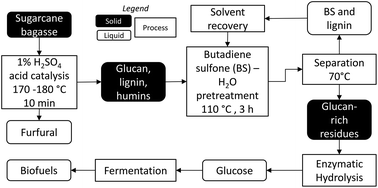Pretreatment of furfural residues with switchable butadiene sulfone in the sugarcane bagasse biorefinery†
Abstract
The mature furfural industry mostly under-utilizes its cellulose-rich solids as a boiler fuel. In this paper, a new sugarcane bagasse biorefinery concept was studied using switchable butadiene sulfone in the presence of water (BSW) to pretreat the solid residues after production of furfural followed by enzymatic hydrolysis of the cellulose fraction for potential production of biofuels. Butadiene sulfone is a solvent that is inexpensive, easily recyclable, with low toxicity, and effective as a biomass pretreatment agent under mild conditions, characteristics that make BSW a greener pretreatment alternative. In this biorefinery concept, hemicellulose (xylan) in sugarcane bagasse was converted in a batch reactor to furfural via dilute sulfuric acid catalysis at 170 °C and 180 °C for 10 min. The furfural yields were comparable to industrial batch production, achieving 38% and 50% of the theoretical yield at 170 °C and 180 °C, respectively. Under these conditions, unwanted humins (pseudo-lignin) formed mostly from xylan and were observed by an increase in the total lignin composition. The mild BSW pretreatment at 110 °C for 3 h solubilized 21.6% to 27.9% of the solids consistent with the removal of 38.6% and 32.5% of the total lignin prior to enzymatic hydrolysis.


 Please wait while we load your content...
Please wait while we load your content...